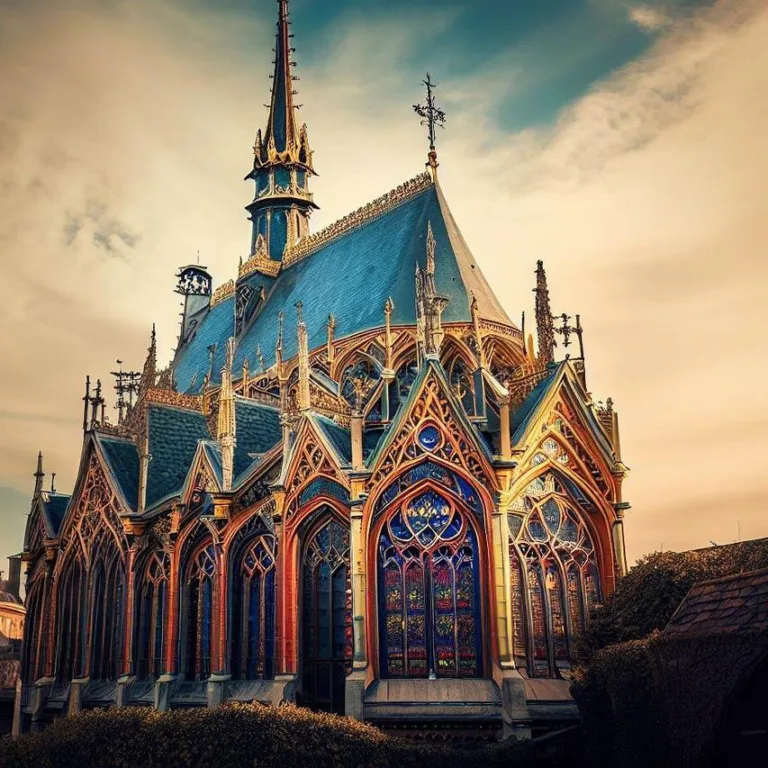Welcome to our comprehensive exploration of the captivating masterpiece known as Saint Chapelle. As a remarkable exemplar of Gothic architecture, Saint Chapelle stands as a testament to the artistic and cultural brilliance of its time. With its intricate stained glass windows, awe-inspiring interior, and historical significance, Saint Chapelle continues to captivate visitors from around the world.
The magnificent creation of saint chapelle
Saint Chapelle, situated in the heart of Paris, France, is a jewel of Gothic architecture. It was commissioned by King Louis IX in the 13th century to house significant religious relics, including the Crown of Thorns. Construction commenced in 1241 and was completed relatively swiftly, with the chapel’s consecration occurring in 1248. The rapid construction period was a testament to the king’s deep devotion and desire to create a monument that would stand as a symbol of his piety.
Gothic grandeur in architecture
The architecture of Saint Chapelle is a brilliant embodiment of the Gothic style, characterized by its soaring heights, pointed arches, ribbed vaults, and intricate ornamentation. The chapel’s exterior, though relatively modest, gives little indication of the breathtaking spectacle that awaits within. The real marvel lies in its interior, where a stunning display of stained glass windows stretches from floor to ceiling.
The Enchanting Stained Glass Windows
The stained glass windows of Saint Chapelle are undoubtedly its most striking feature. These meticulously crafted windows depict biblical stories and events, creating a kaleidoscope of colors that dance across the interior space. The visual effect is nothing short of breathtaking, as sunlight filters through the glass, casting a mesmerizing glow that envelops the visitors in an ethereal ambiance. The 15 stained glass windows narrate the history of the world, from Genesis to the arrival of the relics in Paris.
Historical significance and preservation
Beyond its architectural marvels, Saint Chapelle holds immense historical importance. It was not only a place of worship but also a political and cultural symbol. The chapel survived tumultuous times, including the French Revolution, which saw the destruction of many religious artifacts. While some damage occurred, efforts to restore and preserve the chapel’s splendor were undertaken in the 19th century.
Awe-Inspiring Visitor Experience
Today, Saint Chapelle continues to welcome visitors, offering a unique and awe-inspiring experience. Stepping into the chapel is like entering a world of divine radiance and artistic brilliance. The delicate details, vibrant colors, and architectural precision create an atmosphere of reverence and wonder. Visitors often find themselves immersed in contemplation and admiration for the artistry that gave birth to this magnificent place.
Frequently Asked Questions (FAQs)
Q: What is the significance of Saint Chapelle’s stained glass windows?
A: The stained glass windows of Saint Chapelle are renowned for their intricate depictions of biblical stories, which were designed to educate and inspire the faithful. The windows also served as a visual representation of the King’s devotion and authority.
Q: Can I visit Saint Chapelle?
A: Yes, Saint Chapelle is open to the public. Visitors can explore its stunning interiors and marvel at the breathtaking stained glass windows that have made it famous.
Q: How long did it take to build Saint Chapelle?
A: Construction of Saint Chapelle began in 1241 and was completed in 1248, making it a remarkable achievement in terms of speed and architectural finesse.
Q: Is Saint Chapelle only a religious site?
A: While Saint Chapelle was initially built as a place to house religious relics, it is also a masterpiece of architectural and artistic excellence, attracting visitors for its historical significance and visual splendor.
Q: Can I book tours of Saint Chapelle?
A: Yes, guided tours of Saint Chapelle are available, providing insightful commentary on the history, architecture, and cultural significance of this remarkable Gothic treasure.
Viz také:






